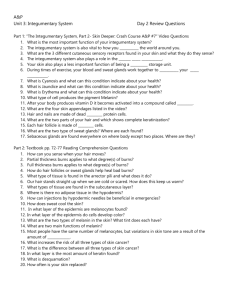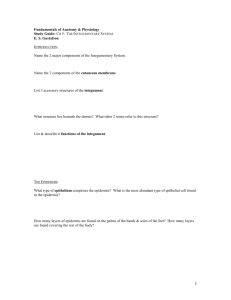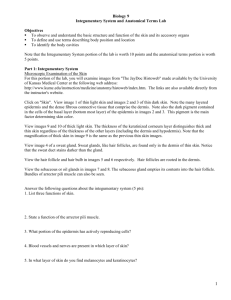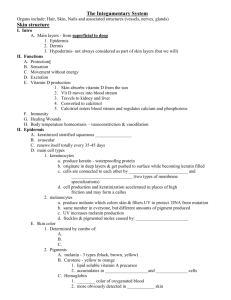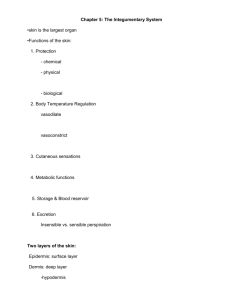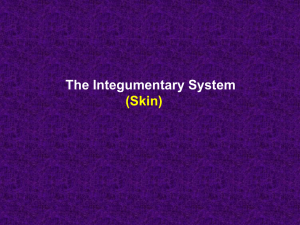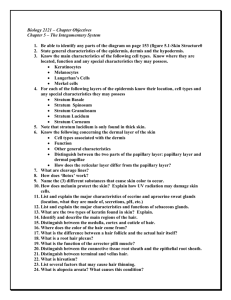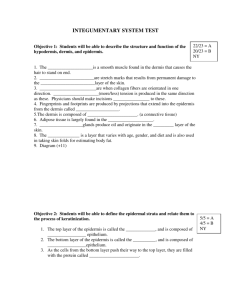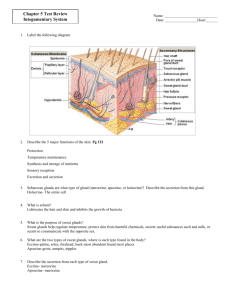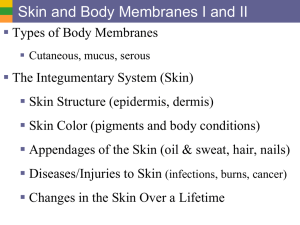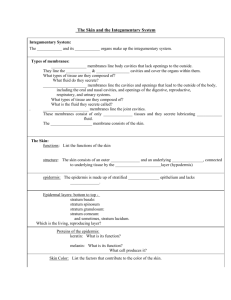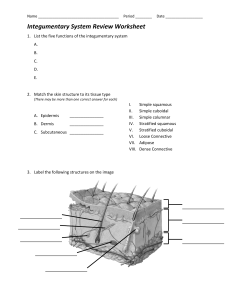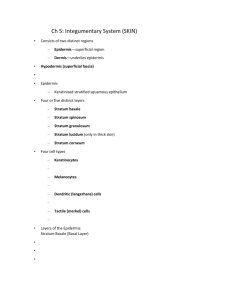Ch. 6 - The Integumentary System
advertisement
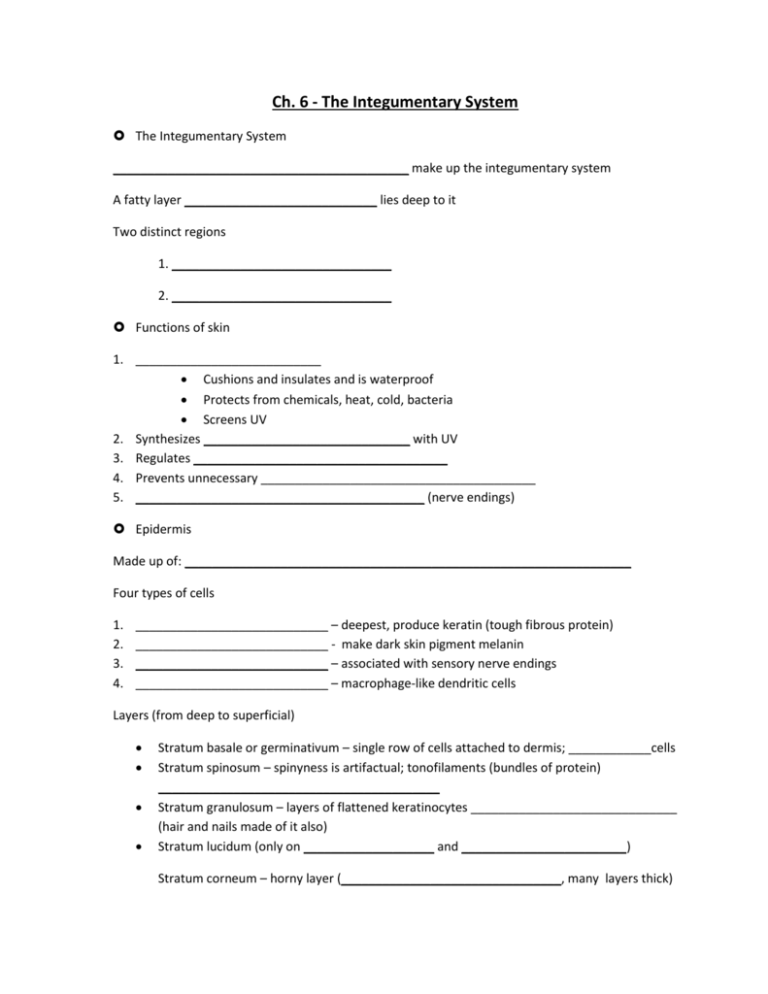
Ch. 6 - The Integumentary System The Integumentary System ___________________________________________ make up the integumentary system A fatty layer ____________________________ lies deep to it Two distinct regions 1. ________________________________ 2. ________________________________ Functions of skin 1. ___________________________ Cushions and insulates and is waterproof Protects from chemicals, heat, cold, bacteria Screens UV 2. Synthesizes ______________________________ with UV 3. Regulates _____________________________________ 4. Prevents unnecessary ________________________________________ 5. __________________________________________ (nerve endings) Epidermis Made up of: _________________________________________________________________ Four types of cells 1. 2. 3. 4. ____________________________ – deepest, produce keratin (tough fibrous protein) ____________________________ - make dark skin pigment melanin ____________________________ – associated with sensory nerve endings ____________________________ – macrophage-like dendritic cells Layers (from deep to superficial) Stratum basale or germinativum – single row of cells attached to dermis; ____________cells Stratum spinosum – spinyness is artifactual; tonofilaments (bundles of protein) _________________________________________ Stratum granulosum – layers of flattened keratinocytes ______________________________ (hair and nails made of it also) Stratum lucidum (only on ___________________ and ________________________) Stratum corneum – horny layer (________________________________, many layers thick) Four basic types of tissue ___________________________________ – epidermis ___________________________________ - dermis ___________________________________ ___________________________________ Dermis _________________________________________ connective tissue: your “hide” Cells: fibroblasts, macrophages, mast cells, WBCs Fiber types: collagen, elastic, reticular Rich supply of ______________________ and _______________________ Critical role in _____________________________________________________ (the vessels) Two layers 1. ______________________________ – areolar connective tissue; includes dermal papillae 2. ____________________________ – “reticulum” (network) of collagen and reticular fibers Fingerprints, palmprints, footprints Dermal papillae lie atop dermal ________________________________ Elevate the overlying epidermis into epidermal ridges ________________________________________ determined Flexion creases ___________________________________________, from continual folding Fibers _______________________________: strength and resilience _______________________________________________: stretch-recoil Striae: ________________________________________________ Tension lines (or lines of cleavage) The direction the bundles of fibers are directed Hypodermis “____________________________” (Gk) = below the skin “____________________________” (Latin) = below the skin Also called “superficial fascia” “fascia” (Latin) =band; in anatomy: sheet of connective tissue Fatty tissue which _________________________ and ________________________ (areolar tissue and adipose cells) Different patterns of accumulation for _____________________________________ Skin color Three skin pigments 1. __________________________________: the most important 2. __________________________________: from carrots and yellow vegies 3. __________________________________: the pink of light skin Melanin in granules passes from melanocytes (same number in all races) to keratinocytes in stratum basale Digested by lysosomes Variations in color Protection from UV light vs vitamin D? Skin appendages Derived from _________________________ but extend into __________________________ Include Hair and hair follicles __________________________________(oil) glands Sweat (___________________________) glands Nails Nails Of hard _________________________________ Corresponds to hooves and claws Grows from nail______________________________________- Hair and hair follicles: complex Derived from epidermis and dermis __________________________________________ palms, soles, nipples, parts of genitalia Functions of hair _______________________________ – less in man than other mammals _______________________________________________________ of the skin ____________________________________-- - scalp Parts _____________________________ imbedded in skin _____________________________ projecting above skin surface Make up of hair – __________________________________________________ Three concentric layers 1. _________________________________ (core) 2. _________________________________ (surrounds medulla) 3. _________________________________ (single layers, overlapping) Types of hair 1. Vellus: fine, short hairs 2. Intermediate hairs 3. Terminal: longer, courser hair Hair growth: averages ___________________________________________ Active: growing Resting phase then shed Hair loss Thinning – ____________________________________________ Male pattern baldness Hair color _________________________________ for black or brown; distinct form of melanin for red White: _______________________________ and ______________________ in the medulla __________________________________ though influenced by hormones and environment Sebaceous (oil) glands Entire body except ___________________________________________________-Produce ________________________ by holocrine secretion Oils and lubricates Sweat glands Entire skin surface except nipples and part of external genitalia _____________________________________________________________________ 500 cc to 12 l/day! (is mostly water) Humans most efficient (only mammals have) Produced in response to ____________________________ as well as __________________ Types of sweat glands ______________________________ or merocrine o Most numerous o True sweat: 99% water, some salts, traces of waste o Open through __________________________ _______________________________________ o Axillary, anal and genital areas only o Ducts open into ___________________________________________ o The organic molecules in it decompose with time –causes _____________________ _________________________________________________ glands o Ceruminous – secrete ________________________ o Mammary – secrete ____________________ Disorders of the integumentary system Burns Threat to life Catastrophic loss of __________________________________________ Dehydration and fatal circulatory shock ________________________________________ Types First degree – epidermis: redness (e.g. sunburn) Second degree – epidermis and upper dermis: blister Third degree - full thickness Infections Skin cancer Critical burns Over __________________ of the body has third-degree burns _______________________ of the body has second-degree burns Third-degree burns on ____________________________________________________ Tumors of the skin Benign, e.g. warts Cancer – associated with UV exposure (also skin aging) Aktinic keratosis - premalignant Basal cell - cells of ____________________________________________________ Squamous cell - _________________________________________ Melanoma – __________________________: most dangerous; recognition: (ABCD rule) A - Asymmetry B - Border irregularityw C - Colors D - Diameter larger than 6 mm


